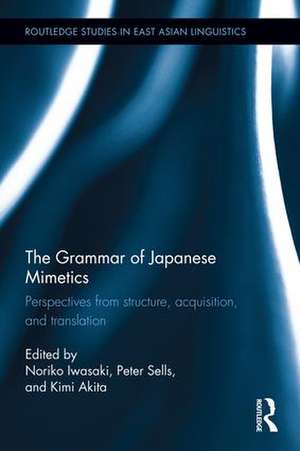The Grammar of Japanese Mimetics: Perspectives from structure, acquisition, and translation: Routledge Studies in East Asian Linguistics
Editat de Noriko Iwasaki, Peter Sells, Kimi Akitaen Limba Engleză Hardback – 13 dec 2016
| Toate formatele și edițiile | Preț | Express |
|---|---|---|
| Paperback (1) | 389.38 lei 43-57 zile | |
| Taylor & Francis – 26 sep 2019 | 389.38 lei 43-57 zile | |
| Hardback (1) | 820.32 lei 43-57 zile | |
| Taylor & Francis – 13 dec 2016 | 820.32 lei 43-57 zile |
Preț: 820.32 lei
Preț vechi: 1178.37 lei
-30% Nou
Puncte Express: 1230
Preț estimativ în valută:
156.96€ • 164.33$ • 129.88£
156.96€ • 164.33$ • 129.88£
Carte tipărită la comandă
Livrare economică 07-21 aprilie
Preluare comenzi: 021 569.72.76
Specificații
ISBN-13: 9781138181908
ISBN-10: 1138181900
Pagini: 252
Ilustrații: 18 Line drawings, black and white; 4 Halftones, black and white; 27 Tables, black and white; 22 Illustrations, black and white
Dimensiuni: 156 x 234 x 19 mm
Greutate: 0.48 kg
Ediția:1
Editura: Taylor & Francis
Colecția Routledge
Seria Routledge Studies in East Asian Linguistics
Locul publicării:Oxford, United Kingdom
ISBN-10: 1138181900
Pagini: 252
Ilustrații: 18 Line drawings, black and white; 4 Halftones, black and white; 27 Tables, black and white; 22 Illustrations, black and white
Dimensiuni: 156 x 234 x 19 mm
Greutate: 0.48 kg
Ediția:1
Editura: Taylor & Francis
Colecția Routledge
Seria Routledge Studies in East Asian Linguistics
Locul publicării:Oxford, United Kingdom
Public țintă
Postgraduate and ProfessionalCuprins
Introduction
Part I: Grammatical and Semantic Properties of Mimetics in Japanese1. The Significance of the Grammatical Study of Japanese Mimetics (Peter Sells)
2. Grammatical and Functional Properties of Mimetics in Japanese (Kimi Akita)
3. The Position of to-/∅-marked Mimetics in Japanese Sentence Structure (Kiyoko Toratani)
4. Swarm-type Mimetic Verbs in Japanese (Ann Wehmeyer)
5. How Flexible Should the Grammar of Mimetics Be? A View from Japanese Poetry (Natsuko Tsujimura)
Part II: Acquisition of Mimetics (As a First or Second Language)
6. Mimetics as Japanese Root Infinitive Analogues (Keiko Murasugi)
7. Grammar of Japanese Mimetics used by English and Korean Learners of L2 Japanese in KY Corpus Interviews: Does L1-L2 Similarity Help? (Noriko Iwasaki)
8. Acquisition of Mimetics and the Development of Proficiency in L2 Japanese: A Longitudinal Case Study of an L1 Dutch Speaker’s Speech and Gesture (Keiko Yoshioka)
9. Use of Mimetics in Motion Event Descriptions by English and Korean Learners of L2 Japanese: Does Language Typology Make a Difference? (Noriko Iwasaki)
Part III: Mimetics and Translation
10. Translating into Japanese Mimetics: Grammatical Class-shifts and Historical Development (Mika Kizu and Naomi Cross)
Part I: Grammatical and Semantic Properties of Mimetics in Japanese1. The Significance of the Grammatical Study of Japanese Mimetics (Peter Sells)
2. Grammatical and Functional Properties of Mimetics in Japanese (Kimi Akita)
3. The Position of to-/∅-marked Mimetics in Japanese Sentence Structure (Kiyoko Toratani)
4. Swarm-type Mimetic Verbs in Japanese (Ann Wehmeyer)
5. How Flexible Should the Grammar of Mimetics Be? A View from Japanese Poetry (Natsuko Tsujimura)
Part II: Acquisition of Mimetics (As a First or Second Language)
6. Mimetics as Japanese Root Infinitive Analogues (Keiko Murasugi)
7. Grammar of Japanese Mimetics used by English and Korean Learners of L2 Japanese in KY Corpus Interviews: Does L1-L2 Similarity Help? (Noriko Iwasaki)
8. Acquisition of Mimetics and the Development of Proficiency in L2 Japanese: A Longitudinal Case Study of an L1 Dutch Speaker’s Speech and Gesture (Keiko Yoshioka)
9. Use of Mimetics in Motion Event Descriptions by English and Korean Learners of L2 Japanese: Does Language Typology Make a Difference? (Noriko Iwasaki)
Part III: Mimetics and Translation
10. Translating into Japanese Mimetics: Grammatical Class-shifts and Historical Development (Mika Kizu and Naomi Cross)
Notă biografică
Noriko IWASAKI, Department of Linguistics, SOAS University of London, United Kingdom
Peter SELLS, Department of Language and Linguistic Science, University of York, United Kingdom
Kimi AKITA, Department of Japanese Language and Culture, Nagoya University, Japan
Peter SELLS, Department of Language and Linguistic Science, University of York, United Kingdom
Kimi AKITA, Department of Japanese Language and Culture, Nagoya University, Japan
Descriere
Mimetic words, also known as ‘sound-symbolic words’, ‘ideophones’ or ‘onomatopoeia’, constitute an important subset of the Japanese lexicon as well as that of other Asian languages and sub-Saharan African languages. It plays a central role in Japanese grammar and feature in children’s early utterances. Through accounts of mimetics from the perspectives of morpho-syntax, semantics, language development and translation of mimetic words, this book aims to bridge the gap between the research on Japanese mimetics and its availability to an international audience, and provides a better understanding of grammatical and structural aspects of sound-symbolic words from a Japanese perspective.





